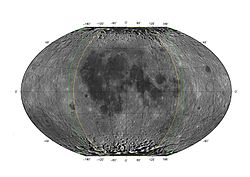This article focuses only on one specialised aspect of its subject.(July 2020) |


In lunar astronomy, libration is the cyclic variation in the apparent position of the Moon that is perceived by observers on the Earth and caused by changes between the orbital and rotational planes of the moon. It causes an observer to see slightly different hemispheres of the surface at different times. It is similar in both cause and effect to the changes in the Moon's apparent size because of changes in distance. It is caused by three mechanisms detailed below, two of which cause a relatively tiny physical libration via tidal forces exerted by the Earth. Such true librations are known as well for other moons with locked rotation.
Contents
- Lunar libration
- Physical libration
- Forced physical libration
- Free physical libration
- See also
- References
- External links
The quite different phenomenon of a trojan asteroid's movement has been called Trojan libration, and Trojan libration point means Lagrangian point.







